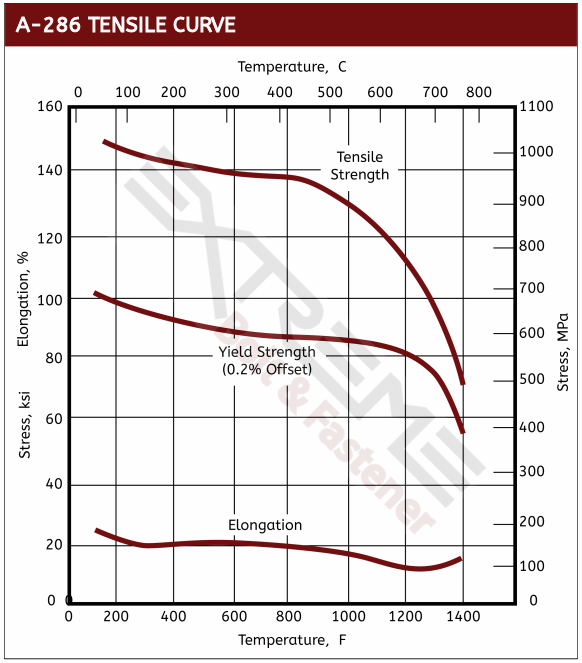 At elevated temperatures of beyond 1000°F, fasteners face a variety of complications which impact their performance. In this article, we will look at some common problems related to elevated temperatures and make recommendations of the best materials to address them.
At elevated temperatures of beyond 1000°F, fasteners face a variety of complications which impact their performance. In this article, we will look at some common problems related to elevated temperatures and make recommendations of the best materials to address them.
One of the most common problems which occurs at elevated temperature is the oxidation of the material. Essentially, in an oxygen rich environment, many common fastener materials like 316 stainless steel will rapidly oxidize or “rust”. To minimize this effect there are a range of oxidation resistant alloys that should be considered for fasteners applications. The alloys listed below are generally good choices to consider if this is your main problem.

A-286 Alloy: This is an iron
-nickel-chrome age-hardenable alloy with good mechanical properties. The alloy maintains its strength and oxidation resistance at temperatures up to about 1300°F
Nickel Alloys: Inconel 600, 625 and 718 all have excellent oxidation resistance in conjunction with high temperature strength properties. These alloys are oxidation resistant up to temperatures of 1800°F – 2000°F depending on the exact grade.

Strength at Elevated Temperatures
Another common issue with fasteners at elevated temperatures is that as temperature increase the strength of the material decreases. While this happens to virtually all materials, there are some metal alloys that perform better than others. If a fastener’s strength is a primary concern for your application, some of the best materials to use are nickel alloys. The nickel alloys shown (Inconel 600, 601, 625 and 718) are some of the best materials to maintain their strength in hot conditions. See the Tensile Data Charts to compare.
Refractory Metals for Vacuum Furnaces
In vacuum furnaces where temperatures could exceed 2000°F of 3000°F, refractory metals are generally required. Refractory metals have incredibly high melting points so they are very stable and strong at high temperatures but their weakness is that they must not be exposed to oxygen at temperatures above 500°F. At temperatures above this, they oxidize rapidly and in the case of molybdenum it will actually vaporize.
Molybdenum: This is a refractory metal with a usable temperature limit of around 2900°F. TZM is an alloyed version molybdenum providing additional strength. Both must be used in oxygen free environments and are commonly used in vacuum furnaces.
Tantalum: Tantalum is a refractory metal with a usable temperature limit of 3600°F. Tantalum fasteners are best known for their corrosion resistance, but are often used because of their high temperature stability and inertness in semiconductor processing. Tantalum fasteners are available as commercialy pure tantalum and tantalum 2.5% tungsten.


Ceramics – For the Hottest Applications
When nickel alloys are not good enough and refractory metals can’t do the job, ceramic materials allow fasteners to operate in environments up to 3000°F – 4000°F. These materials are the ultimate for high temperature fasteners, but have mechanical drawbacks as they have limited strength and can be brittle.
Alumina: This is one of the most commonly materials for ceramic fasteners. It is known for its excellent electrical insulation properties, as well as its high level of hardness and wear-resistance. Yet beware, this material has a low level of strength and fracture support.
Zirconia: Yittria stabilized zirconia, as it is also known, offers the best combination of strength and temperature stability. This material is the ideal choice when additional strength is need beyond the capabilities of alumina ceramics.


We need suggestions on bolts for high temperature turbocharger at ~1100°F while under stress. We are considering changing over to alloy bolts on all future engines in production. Our current material is SS.
Hello,
Typical stainless steels will struggle at those temperatures especially with cycling. A great material that you might want to consider for this application is A-286. This can be made in a few different versions ranging from 120 – 160 KSI tensile. A-286 fasteners are great for high temperature and high strength applications. These screws would be very resistant to high temperature oxidation and typically can handle the cycling. This will likely be a big improvement over a standard stainless steels like 304 or 316 Stainless Steel.
Dean